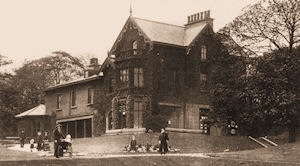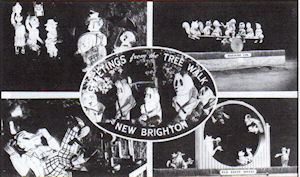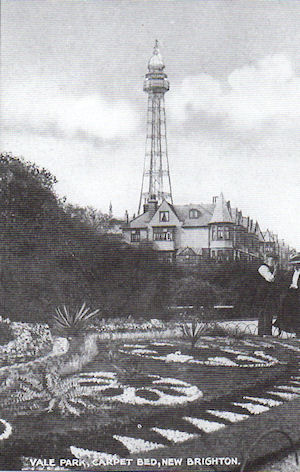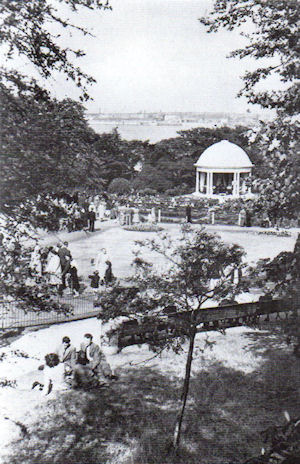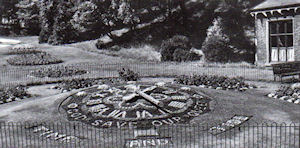 |
Map 1935. Click to view full map. |
A Free Avenue Into Their Own Property
I don't know what the Poulton Piccanninies are doing these days, but they helped to start Vale Park off with a song and a dance.
These 'juvenile artistes' performed at the park's opening ceremony on Whit Sunday, 20th May 1899. Another entertainer rendered an 'excellent female impersonation with the song 'Killarney', as a newspaper of the day described it. It must have been some opening.
Vale Park is a miniature jewel, a mere 200 yards by 200 yards. It lies snugly on the Wirral bank of the River Mersey, a stone's skip from the sadly-missed New Brighton pier.
From the 1890s onwards Wallasey Urban District Council provided 'lung' spaces for the population, building the promenade from Egremont Ferry to New Brighton, and creating Central Park, Earlston Gardens, and Marine Park as well as paying £7,750 for Vale Park ground and estates.
Urban District Council purchased the 25 acre Liscard Vale Estate for £7,750 also the Woodlands Estate both in 1898 and merged them into Vale Park, opening to the public in 1899. |
The Council stayed tight-pursed for the opening ceremony, so George Coombs, Chairman of the Council's Parks Committee, dug into his own pocket to pay for entertainment and refreshments for two hundred invited guests. As he ceremoniously opened the promenade gates that day, he told the gathered public they had 'A free avenue into their own property, for their free enjoyment and use for all time.'
The park has, still, the flavour of a park from Victorian times, with paths winding through wooded plantations, a laburnum arch, and formal flower beds surrounded by wooded benches. On a Summer's day with clouds billowing over the river, you are easily drawn into sitting down to watch the flowers grow.
The park's development doesn't start with the opening. Once common land, by 1831 it was a private estate known as 'Liscard Vale'. Later on the land was split into two estates, one keeping the name 'Liscard Vale'. the other being called 'The Woodlands'. When the Council bought the properties in 1898 there were three residences on The Woodlands, but all were demolished by 1910. Only the present Vale House and its associated lodge and coach house were left standing on Liscard Vale.
The grounds have always had an idyllic quality. Samuel Smith, one-time Liverpool MP who lived there in the 1860s, records "We made our home in Liscard Vale, New Brighton, in a sweet situation embosomed in trees, and with grounds reaching to the shore of the Mersey; there we spent some ten happy years".
We probably have William Grinsell Burston, the first park gardener, to thank for the delightful flower beds and neatly trimmed lawns we see on early postcards and photographs. He was previously employed by the Holland family, who lived at Vale House estate. George Davison, born next to the park in 1914, remembers him. 'He was a nice, quiet chap, always helping visitors who asked for gardening tips.' William died at Vale House in 1918. Ernest Burston, Williams's youngest son worked as a Vale Park gardener between 1918 and 1946 living with his wife in Vale House which had been converted into two flats following his father's death.
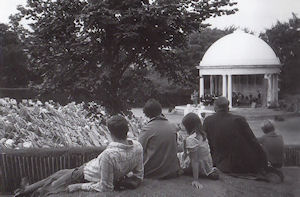 |
In 1978 a family enjoy a free concert. Only the deck chair patrons paid. The domed roof bandstand had been erected in 1926. One of the favourite entertainments was 'Joytime' which began in 1953. |
During the 1920's and 30's people came to Vale Park to sip tea and eat ice cream on the terrace in front of Vale House. And to listen to the Band Concerts.
The Band Concerts have been a feature since the first day, when the Tranmere Prize Gleam Silver Band played the crowd in with the National Anthem. Since then many famous bands have played in the park, including works bands like Grimethorpe, Fodens, Fairey and Cammell Laird.
The building of a doric-columed bandstand with a domed roof was opined on 21st August, 1926 and it provided a majestic backdrop to the concerts. The bandstand was built by Messrs. Boulton and Paul, of Norwich and the reconstructed stonework and plastering was carried out by Messrs. Crotch and Son, of Norwich. It is still used by the bands on Sundays during the summer.
The 'Greetings from the Tree Walk New Brighton' postcard, depicts nursery rhyme figures lit up in Vale Park, in the 1950s. The tree walk was a long a suspended boardwalk which went through the trees at quite a height with larger than life animals lit up - some lit up in sequence to give the impression the squirrels were running up the tree and the rabbits were hopping. |
During the Second World War, a barrage balloon was tethered in the park, helping to protect Wallasey from Hitler's bombers. After the war the Council, ever mindful that grass was for looking at, not playing on, wanted to make playing ball games in the park a criminal offence. The Secretary of State refused their request, saying it was "unreasonable".
The grounds appear to have been landscaped at the same time Vale House was built circa 1835, so some of the trees are almost 170 years old. The children's play area, completely refurbished in 1989, houses an old spreading beech which has been a climbing frame for generations of children. Its beech nuts provide food for the grey squirrels, as do the oak trees dotted around the park.
‘Joytime’, a children’s talent show, was started in Vale Park by Norman Trafford and his wife, Dorothy (Uncle Norman and Aunty Dorothy), in 1953 and ran for 45 years, becoming the longest running children’s show of its kind. Norman was a local postman and passed away in 1977 whilst Dorothy carried on until ill health forced her to stop in 1997, before passing away in 1998. In 1992 Dorothy was awarded the British Empire Medal. During the summer school holidays children would take to the stage for their five minutes of fame. The winner of each day’s contest would go on to the final on Friday, with the winner going on to the Grand Final at the Floral Pavilion at the end of the summer. A children's show still takes place at the bandstand during the summer months, organised by a voluntary committee.
During the 1970's and 80's, as a sign of the times, most features requiring maintenance were eliminated from the park. A heated conservatory housing tropical plants, a floral clock, a pool and a large rockery have all disappeared.
In 1984 a Park Ranger was based in the park to give walks, talks and slide shows and in 1989 the Coach House was refurbished and made in to a visitor centre. In 1991 a voluntary group, 'The Friends of Vale Park' was set up to organise events and act as a pressure group.
This postcard was sent on 17th April 1925. Postcards with a picture of the Tower were still popular even though the dismantling of the Tower had been completed in 1921 . Carpet beds were a feature of Vale Park and Ald. and Mrs John Pennington. Mayor and Mayoress in 1943-45, presented a floral clock. |
Looking down on Vale Park with its bandstand and the River Mersey beyond. Wirral's first Green Flag was awarded to Vale Park in 1915. |
This specially designed floral clock for the Queen's Coronation was in Vale Park. The messages in flowers around the clock said "God Save Our Queen" and the message outside the clock "Time And Tide". |
|
Featured sites
- Non Gamstop Casinos
- Casino Not On Gamstop
- UK Casinos Not On Gamstop
- Non Gamstop Casinos UK
- Sites Not On Gamstop
- Sites Not On Gamstop
- Casinos Not On Gamstop
- Casinos Not On Gamstop
- Casinos Not On Gamstop
- Non Gamstop Casino UK
- Casinos Not On Gamstop
- Non Gamstop Casino
- UK Online Casinos Not On Gamstop
- UK Online Casinos Not On Gamstop
- Non Gamstop Casinos
- Casino Sites Not On Gamstop
- Casinos Not On Gamstop
- Casinos Not On Gamstop
- Best Betting Sites
- Casinos Not On Gamstop
- Gambling Sites Not On Gamstop
- Betting Sites That Are Not On Gamstop
- Non Gamstop Casinos UK
- UK Online Casinos Not On Gamstop
